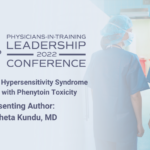Abstract | April 6, 2022
Anticonvulsant Hypersensitivity Syndrome in a Patient with Phenytoin Toxicity
Learning Objectives
- To discuss about AHS which is a very rare multi organ drug reaction with incidence ranging from 1 in 1000 to 1 in 10,000 exposures;
- To identify antiepileptic drugs which are the common offending agents: phenytoin, phenobarbital and carbamazepine all of which are cyclical antiepileptics;
- To discuss about the mechanism of AHS which is attributed to three components: deficiency of epoxide hydroxylase enzyme which detoxifies the metabolites of cyclical anticonvulsants; certain HLA antigen subtypes including HLA-A3101 and reactivation of herpes viruses. Given the high rate of HLAA3101 worldwide, it is imperative to have a low index of suspicion for AHS in the right clinical context.
Introduction: Phenytoin is a commonly used antiepileptic agent with significant adverse reactions ranging from horizontal nystagmus, altered mental status to ataxia and coma. Phenytoin follows zero order kinetics in higher doses, leading to variable half-life and drug toxicity. Very rarely it can cause Anticonvulsant Hypersensitivity Syndrome (AHS) which is a multi-organ drug reaction associated with aromatic anticonvulsants, characterized by fever, rash, lymphadenopathy, eosinophilia and internal organ involvement. It usually presents 1 to 8 weeks after exposure.
Case Presentation: The patient is a 53-year-old Caucasian woman who presented with altered mental status, slurred speech and generalized weakness. Her past medical history included seizure disorder and ischemic stroke. On examination she appeared disoriented and had horizontal nystagmus but no focal sensory or motor deficit. Patient was febrile with temperature of 100.2F and maculopapular reddish rash on upper back, chest and buttocks. CT head was normal and EEG did not show any epileptiform discharges. WBCs remained around 8000 and there was gradual rise in eosinophil count from 0.6% to 1.5%. AST was elevated at 65. Blood and urine cultures were negative. Blood phenytoin level was raised at 58mcg/ml.
Diagnosis: Patient was started on phenytoin 2 months ago, with recent modification of doses leading to inadvertent daily consumption of 900mg Phenytoin instead of 300mg. The characteristic symptoms of fever, rash, eosinophilia and internal organ involvement in form of liver injury with Naranjo adverse drug reaction score of 8 helped make the diagnosis of AHS in the setting of phenytoin toxicity.
Management: Phenytoin was stopped immediately and replaced with Levetiracetam. The patient was managed conservatively and received charcoal via nasogastric tube and methyl-prednisolone for 3 days. Serum phenytoin levels gradually decreased to 20 with improvement of encephalopathy and overall condition. She was discharged 2 weeks after admission.

